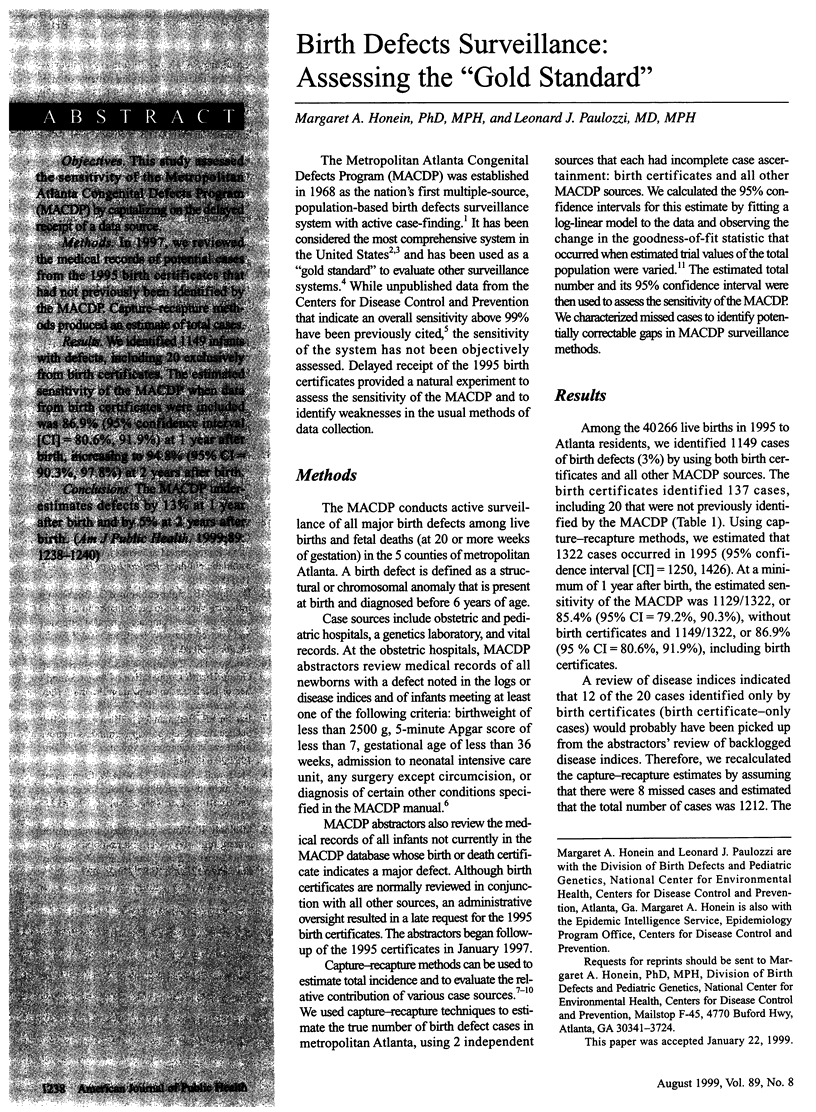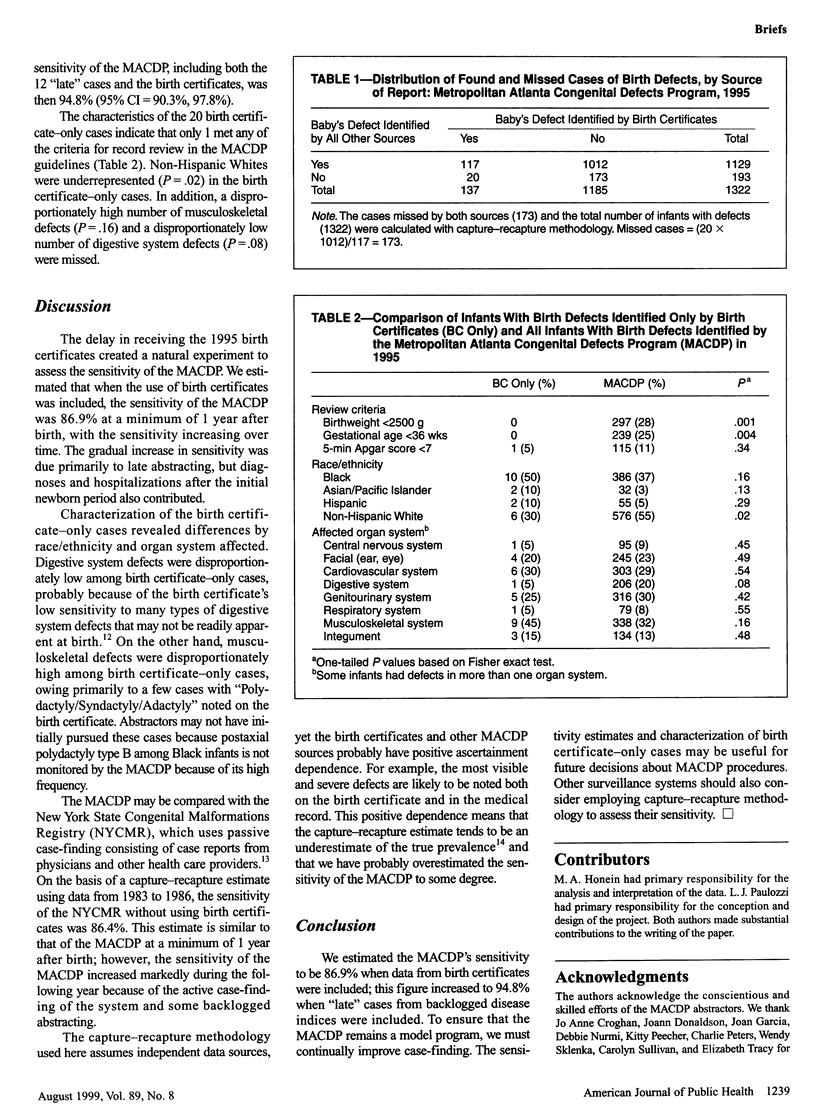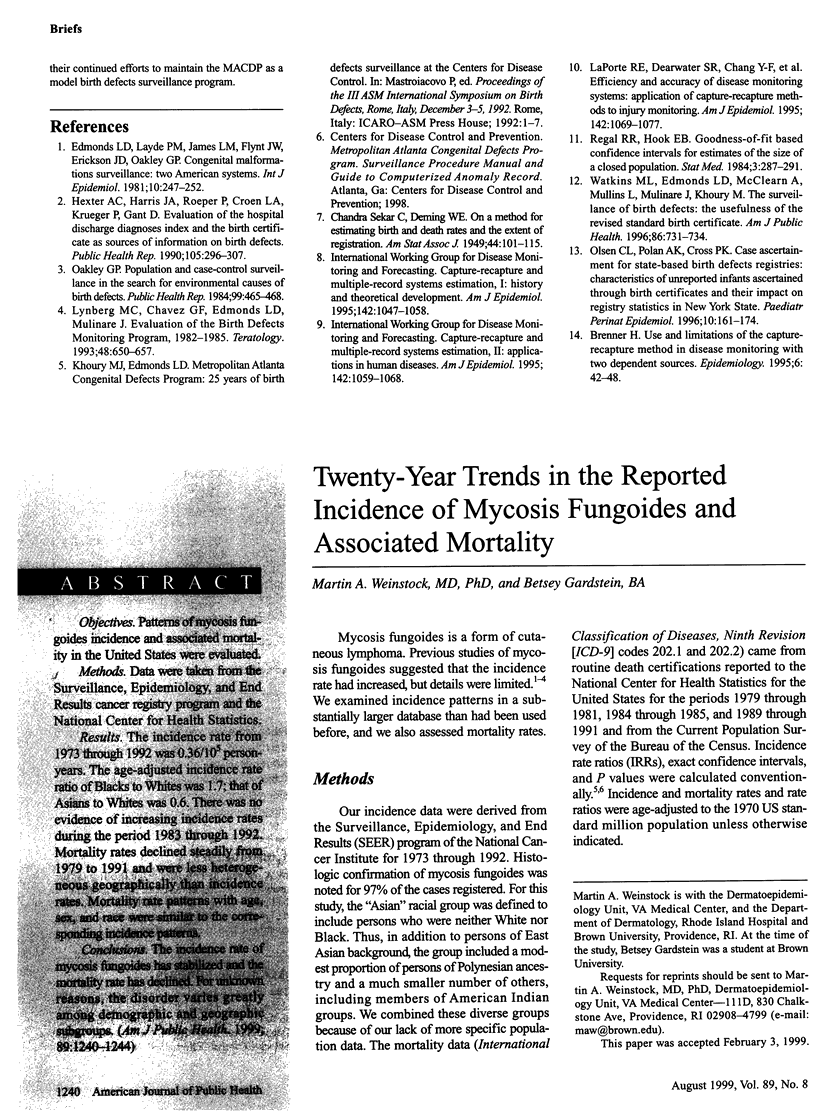Abstract
OBJECTIVES: This study assessed the sensitivity of the Metropolitan Atlanta Congenital Defects Program (MACDP) by capitalizing on the delayed receipt of a data source. METHODS: In 1997, we reviewed the medical records of potential cases from the 1995 birth certificates that had not previously been identified by the MACDP. Capture-recapture methods produced an estimate of total cases. RESULTS: We identified 1149 infants with defects, including 20 exclusively from birth certificates. The estimated sensitivity of the MACDP when data from birth certificates were included was 86.9% (95% confidence interval [CI] = 80.6%, 91.9%) at 1 year after birth, increasing to 94.8% (95% CI = 90.3%, 97.8%) at 2 years after birth. CONCLUSIONS: The MACDP underestimates defects by 13% at 1 year after birth and by 5% at 2 years after birth.
Full text
PDF


Selected References
These references are in PubMed. This may not be the complete list of references from this article.
- Brenner H. Use and limitations of the capture-recapture method in disease monitoring with two dependent sources. Epidemiology. 1995 Jan;6(1):42–48. doi: 10.1097/00001648-199501000-00009. [DOI] [PubMed] [Google Scholar]
- Edmonds L. D., Layde P. M., James L. M., Flynt J. W., Erickson J. D., Oakley G. P., Jr Congenital malformations surveillance: two American systems. Int J Epidemiol. 1981 Sep;10(3):247–252. doi: 10.1093/ije/10.3.247. [DOI] [PubMed] [Google Scholar]
- Hexter A. C., Harris J. A., Roeper P., Croen L. A., Krueger P., Gant D. Evaluation of the hospital discharge diagnoses index and the birth certificate as sources of information on birth defects. Public Health Rep. 1990 May-Jun;105(3):296–307. [PMC free article] [PubMed] [Google Scholar]
- LaPorte R. E., Dearwater S. R., Chang Y. F., Songer T. J., Aaron D. J., Anderson R. L., Olsen T. Efficiency and accuracy of disease monitoring systems: application of capture-recapture methods to injury monitoring. Am J Epidemiol. 1995 Nov 15;142(10):1069–1077. doi: 10.1093/oxfordjournals.aje.a117560. [DOI] [PubMed] [Google Scholar]
- Lynberg M. C., Chavez G. F., Edmonds L. D., Mulinare J. Evaluation of the Birth Defects Monitoring Program, 1982-1985. Teratology. 1993 Dec;48(6):650–657. doi: 10.1002/tera.1420480607. [DOI] [PubMed] [Google Scholar]
- Oakley G. P., Jr Population and case-control surveillance in the search for environmental causes of birth defects. Public Health Rep. 1984 Sep-Oct;99(5):465–468. [PMC free article] [PubMed] [Google Scholar]
- Olsen C. L., Polan A. K., Cross P. K. Case ascertainment for state-based birth defects registries: characteristics of unreported infants ascertained through birth certificates and their impact on registry statistics in New York state. Paediatr Perinat Epidemiol. 1996 Apr;10(2):161–174. doi: 10.1111/j.1365-3016.1996.tb00040.x. [DOI] [PubMed] [Google Scholar]
- Regal R. R., Hook E. B. Goodness-of-fit based confidence intervals for estimates of the size of a closed population. Stat Med. 1984 Jul-Sep;3(3):287–291. doi: 10.1002/sim.4780030310. [DOI] [PubMed] [Google Scholar]
- Watkins M. L., Edmonds L., McClearn A., Mullins L., Mulinare J., Khoury M. The surveillance of birth defects: the usefulness of the revised US standard birth certificate. Am J Public Health. 1996 May;86(5):731–734. doi: 10.2105/ajph.86.5.731. [DOI] [PMC free article] [PubMed] [Google Scholar]


